MV Dirona travel digest for Northland, New Zealand 2013

|
Click the travel log icon on the left to see these locations on a map,
with the complete log of our cruise. On the map page, clicking on a camera or text icon will display a picture and/or log entry for that location, and clicking on the smaller icons along the route will display latitude, longitude and other navigation data for that location. And a live map of our current route and most recent log entries always is available at //mvdirona.com/maps/LocationCurrent.html. |
 |
9/22/2013: Bottom cleaning
Position: -17°44.43'S, 168°18.67'E
New Zealand biosecurity requests that any boat entering the country have it's bottom cleaned at the previous port. We were planning to do this ourselves today, but a local swam over and offered to do it for us.
|
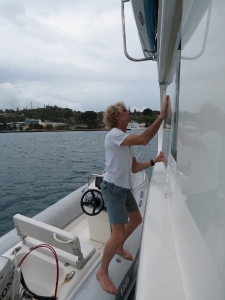 |
9/22/2013: Installing the storm plates
Position: -17°44.43'S, 168°18.67'E
Storm plates protect large expanses of glass against the force of rough seas. Rugged storm-capable boats really have only two options: very small, very thick windows, or larger windows that need protection at sea. Smaller windows make the boat less liveable, and given the frequeuncy of being at sea and the ease in which storm plates can be installed, the latter approach used by Nordhavn works quite well. We only install ours on longer runs when the weather is less predictable. We plan to leave for New Zealand in the next 24 hours and that run certainly qualifies as potentially rough and unpredictable. The three windows on the starboard side are easy because we have a walkway there, but we used to require a dock to do the port side. This time, we tied the dinghy off tightly on the port side and worked from there. It worked out very well, and went on about as quickly as working on a dock with only a tiny increased risk of dropping something.
|
 |
9/23/2013: Vet
Position: -17°44.43'S, 168°18.67'E
Spitfire's New Zealand import permit requires a veterinary health inspection and administration of treatements for internal and external parasites prior to arrival. Vet Bryan Gartrell came on board to do them. Spitfire aced the health exam, but wasn't enthusiastic about taking the large internal parasite pill.
|
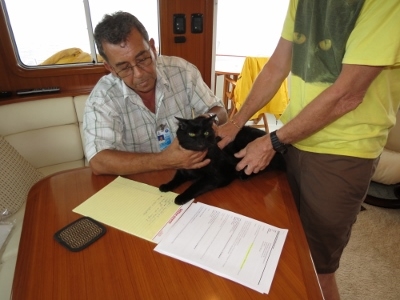 |
9/23/2013: Govt vet
Position: -17°44.43'S, 168°18.67'E
In addition to the health exam and parasite treatments, a government vet (USDA equivalent) at our last port must also inspect Spitfire and attest to his fitness to travel and that all the New Zealand import requirements have been met. Pictured is Roger Phillips of Biosecurity Vanuata.
|
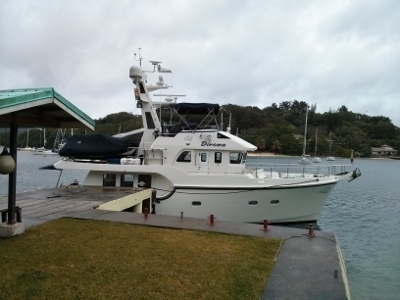 |
9/23/2013: Fueling
Position: -17°44.66'S, 168°18.82'E
At the Yachting World fuel dock. At about ten feet long, it's certainly the smallest dock we've ever tied off to. We did pre-order the fuel, but they didn't have enough for us, so they called a tanker to fill their tanks for us, then we filled ours.
|
 |
9/23/2013: Lunch
Position: -17°44.51'S, 168°18.88'E
We had a couple of hours to burn while waiting for the fuel truck, so we stopped off for lunch at the local brewpub just up the road. Jennifer is wearing a rainjacket--torrential rain has been pouring all day and is just starting to ease up.
|
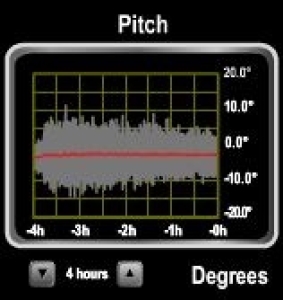 |
9/23/2013: Pitch
Position: -18°4.00'S, 168°19.86'E
We left Port Vila for New Zealand right after fueling. We were leaving just on the tail end of a low-pressure system and are hoping to reach New Zealand before the next low hits there. But we soon should get into a high pressure system with little wind for most of the run. We started off with 5-6' waves on 6-7 seconds on the bow, making for a lumpy ride with 10-15 degree pitching. But the wave period has increased a bit now, so boat movement is lessening.
|
 |
9/24/2013: Sunrise
Position: -19°4.44'S, 168°39.11'E
.
|
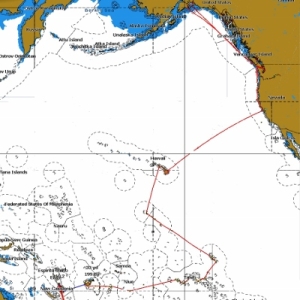 |
9/24/2013: Full route
Position: -19°28.05'S, 168°46.65'E
With our chartplotter zoomed out all the way, we can just barely display all our routes, including Prince William Sound in Alaska. Soon they'll no longer fit on a single screen.
|
 |
9/24/2013: Farthest South
Position: -20°9.80'S, 169°0.05'E
For the past couple of weeks, Vanuauta has been the farthest south (Aneityum) and west (Port Vila) we've been in Dirona. We've just gone our farthest south, but it will be a while before we get farther west than Port Vila.
|
 |
9/25/2013: Pitch
Position: -21°33.54'S, 169°26.10'E
The waves came up again last night, but finally are starting to settle down. Hopefully we're getting into that high-pressure system we saw on the weather models.
|
 |
9/25/2013: Sunset
Position: -23°21.26'S, 169°59.28'E
Seas continue to settle down as that low pressure system moves away and we get into a high pressure system.
|
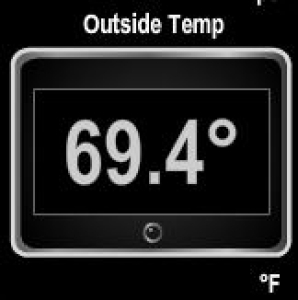 |
9/25/2013: Temperature falling
Position: -23°49.17'S, 170°8.04'E
The temperature is falling noticeably as we proceed south. The air temperature is just under 70F and the water temperature is 77F. Big difference from the 80-degree water and air temperatures we saw through much of this trip.
|
 |
9/26/2013: Sunrise
Position: -24°50.58'S, 170°27.69'E
We're now well into the high-pressure system and are humming along through low, gentle swell with 5-7-knot winds. For sailors these conditions are less than ideal, but we love them. This should last for 2-3 days until we near New Zealand, when we'll meet the edge of a low-pressure system for the last day or so of the run. The weather model indicates seas will be 10-12 feet, but on long 11-13-second periods, so it shouldn't be too bad. But weather models are only as accurate as weather models. :)
|
 |
9/26/2013: Albatross
Position: -25°31.11'S, 170°40.75'E
This albatross put on a great show for us: several times it soared up high then plummeted into the water. Those birds sure range far--we're hundreds of miles from any land.
|
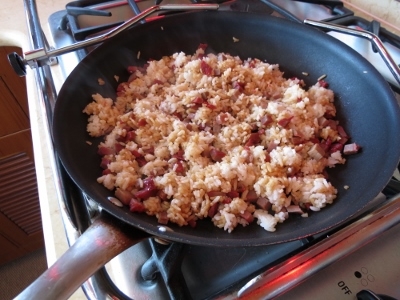 |
9/26/2013: Lunch
Position: -25°36.75'S, 170°42.56'E
Char siu (Chinese barbecued pork) fried rice for lunch. Our stovetop has a stainless steel sea rail to prevent pots from sliding off as the boat moves. And we can attach potholders to the rails as an added precaution (upper left and right in photo). Sailboats typically have the entire stove/oven on gimbals so that the appliance remains reasonably level when the boat is heeled over under sail. Our boat will roll side to side, but not very far and not for very long due to the active stabilization system, so we didn't install stove gimbals.
|
 |
9/26/2013: Conditions
Position: -25°40.06'S, 170°43.64'E
Conditions are excellent: warm and sunny with gentle seas and little wind.
|
 |
9/26/2013: Sunset
Position: -26°22.21'S, 170°57.31'E
Conditions still good--we're really enjoying this part of the run.
|
 |
9/27/2013: Halfway
Position: -27°24.95'S, 171°18.32'E
We're more than halfway through the 1,092-mile trip now. ETA showing is 10pm on the 29th, but we expect to arrive on the morning of the 30th. The ETA fluctuates greatly with sea conditions--and that low pressure system likely will slow us down a fair bit too.
|
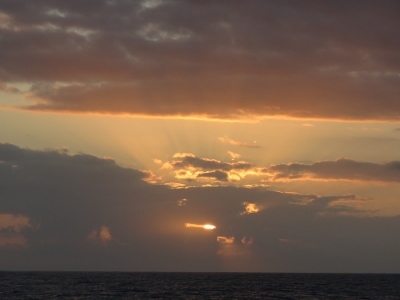 |
9/27/2013: Sunrise
Position: -27°42.94'S, 171°24.39'E
Conditions remain good. But the weather models are still showing that low pressure system reaching New Zealand as we approach. Looks like we'll have about twenty-four hours of eleven-to-thirteen-foot seas, but on a fairly long period with light winds, so it shouldn't be too rough.
|
 |
9/27/2013: Breakfast
Position: -27°51.80'S, 171°27.39'E
Blueberry muffins using the last of the frozen blueberries from Hawaii. We're working all our fresh/frozen produce and meats down as we can't bring any into New Zealand.
|
 |
9/28/2013: Sunrise
Position: -30°39.02'S, 172°25.65'E
Conditions improved even more overnight, with the waves period increasing slightly. But they won't last-- we've still got that low pressure system ahead of us before we can make landfall.
|
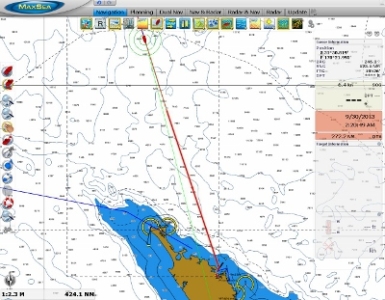 |
9/28/2013: NZ waters
Position: -30°59.76'S, 172°33.13'E
We're within the 200-mile New Zealand territorial waters boundary, but still have 272 miles to go to reach our port of entry at Opua.
|
 |
9/28/2013: Pitch
Position: -32°19.37'S, 173°2.04'E
We're now well into the low pressure system. The weather models have been most accurate on this trip--we're seeing 11 to 13-foot seas on perhaps a 12 to 13-second period on the bow quarter as predicted. This has increased the pitching motion. It's not a big deal--just have to be a little careful moving about as a fair bit of boat motion.
|
 |
9/29/2013: Clipper Ichiban
Position: -33°19.16'S, 173°25.64'E
The Clipper Ichiban, en route to China, is the first boat we've seen since just outside Port Vila. As is suprisingly often the case when we're the only two boats out there, we're on a slight collision course. We adjusted course to give a good 2-mile CPA (Closest Point of Approach).
|
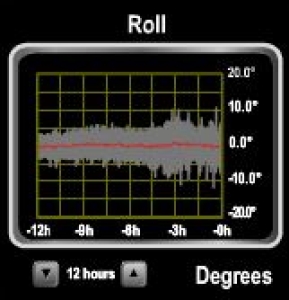 |
9/29/2013: Roll
Position: -33°26.84'S, 173°28.68'E
Again as the model predicted, we're now in 10 to 11-foot beam seas on a gentle 11 to 12-second period and are now seeing much reduced pitch, but more roll. The active stabilizers do a good job of dampening beam seas, so boat motion is substantially reduced over the pitching from taking the waves on the bow quarter. We're just over 120 miles out now and expect to arrive early Monday morning.
|
 |
9/29/2013: Flying squid
Position: -33°50.38'S, 173°38.06'E
No flying fish on this trip--but we did find this squid in the walkway.
|
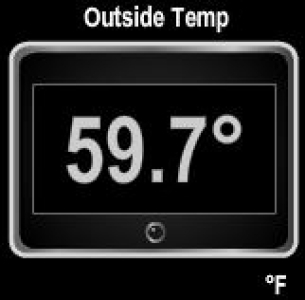 |
9/29/2013: Temperature
Position: -34°8.41'S, 173°45.27'E
The air temperature is below 60F now, and the water temperature is 66F.
|
 |
9/29/2013: Land ho
Position: -34°46.24'S, 174°0.48'E
We can't see land yet by eye, but the radar can. We've now got the wind and waves behind us, so boat motion is minimal and we're having an easy last leg of the run.
|
 |
9/29/2013: Cape Mass
Position: -34°55.33'S, 174°4.15'E
Our second boat sighting of the trip--the ship Cape Mass en route from New Zealand to Australia.
|
 |
9/30/2013: Opua Quarantine dock
Position: -35°18.85'S, 174°7.36'E
After that wonderful weather window from Vanuatu to New Zealand, ironically landing was the most difficult. As we neared the turn to the dock area just past midnight, the winds came up to from 20 kts steady to 25 to 35 and it started to just pelt rain. As we turned in, the helm was sluggish and not responding properly. It turned out to be the impact of a large current. So now we have a very dark night, 25 to 35 kt winds, high current, and back lighting to accompany our landing in a strange marina. That's livin! We ended up circling around the breakwater and coming up the other side where there was little current, the rain backed off to a trickle, and the impact of the wind wasn't that much. It's good to be here.
|
 |
9/30/2013: Sunrise
Position: -35°18.85'S, 174°7.36'E
Our first New Zealand sunrise. We slept very well last night, no suprise there.
|
 |
9/30/2013: Biosecurity clearance
Position: -35°18.85'S, 174°7.36'E
Mike Cartwright from MPI Quarantine Service collecting any banned items before giving us biosecurity clearance. We had no fresh produce when we arrived, but other items he collected were any cooked or raw meats that weren't in their original commercial packaging (we had some USDA beef that we could keep), honey, garlic, ginger, eggs (including powdered and hard-boiled), and popcorn kernels. He also inspected our bicycles for any mud on the tires.
|
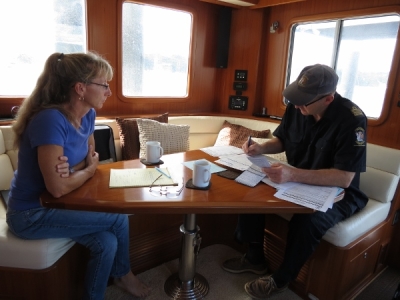 |
9/30/2013: Customs clearance
Position: -35°18.85'S, 174°7.36'E
Gary Burton from NZ Customs Service clearing us through for customs and immigration. We'll be in New Zealand for several months--it will be nice not to go through all that entry and exit paperwork every few weeks.
|
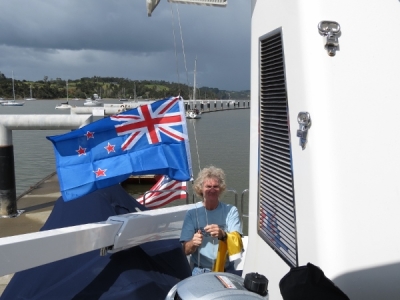 |
9/30/2013: New Zealand courtesy flag
Position: -35°18.85'S, 174°7.36'E
Swapping our quarantine flag for a New Zealand courtesy flag now that we're cleared through.
|
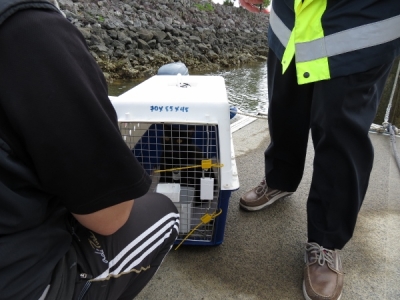 |
9/30/2013: Quarantine
Position: -35°18.85'S, 174°7.36'E
Spitfire heading to the quarantine facility in a biosecurity-sealed cage. The boat feels very empty without him, but we should have him back in 10 days.
|
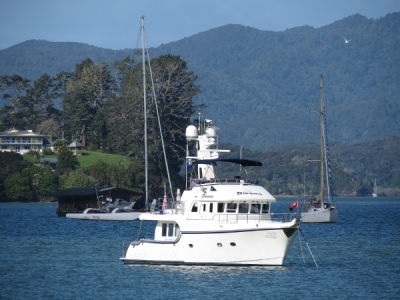 |
9/30/2013: Waikare Inlet
Position: -35°18.72'S, 174°7.54'E
At anchor in Waikare Inlet just off the Opua marina. We're early in the season and the anchorage already is fairly crowded--it must get really packed during the busy season. We'd tried a little north of the marina, but ended up out of WiFi range, so came back to anchor east of the marina.
|
 |
9/30/2013: Ferry
Position: -35°18.74'S, 174°7.26'E
One of the two car ferries that run the short route between Okiato and Opua. With the queen on the currency, the temperature, the topography and the ferries, we felt as if we were in the Gulf Islands in British Columbia, Canada. The only thing missing was French on the street signs.
|
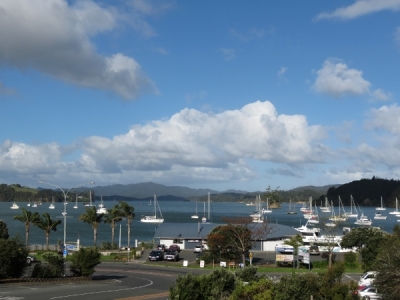 |
9/30/2013: Anchorage view
Position: -35°18.80'S, 174°7.21'E
View to our anchorage just up the road from the ferry dock. Dirona is anchored to the left of center beyond the group of three palm trees.
|
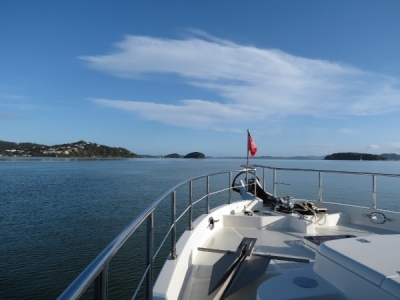 |
10/1/2013: Easy cruising
Position: -35°18.03'S, 174°6.64'E
En route down Veronica Channel in calm seas under a blue sky. Definately a lot easier returning out compared to our midnight arrival.
|
 |
10/1/2013: Passe-Partout
Position: -35°16.78'S, 174°6.02'E
Nordhavn 40 Passe-Partout of Sydney, Australia. They'd cleared in the day before us and stopped by to say hello when passing Paihia.
|
 |
10/1/2013: 35 Degree
Position: -35°16.78'S, 174°6.02'E
The 35 Degrees Aquarium Restaurant and Bar is one of several nice-looking restauruants in Paihia, many along the waterfront. Most of the cruising information we had on Paihia didn't recommend the town for much other than grocery shopping, but we found it quite an appealing destination.
|
 |
10/1/2013: Dog roll
Position: -35°16.78'S, 174°6.02'E
All the grocery stores we went into had selections of these nearly-foot-long dog dinners in a roll. No cat rolls though.
|
 |
10/1/2013: Paihia anchorage
Position: -35°16.77'S, 174°6.01'E
View across the anchorage from a lookout at the south end of town.
|
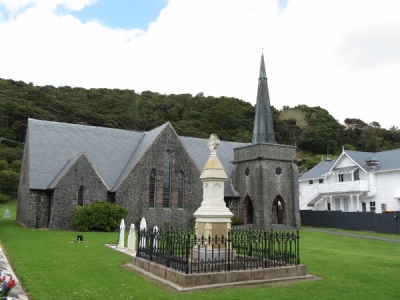 |
10/1/2013: St. Paul's
Position: -35°16.77'S, 174°6.01'E
St. Paul's Anglican Church was ringed with gravestones, several fairly recent with fresh flowers beside them.
|
 |
10/1/2013: Mack Attack
Position: -35°16.77'S, 174°6.01'E
The Mack Attack, a high-speed tour boat that runs out and through "Hole in the Rock" at the tip of Cape Brett. The Paihia dock was busy with tour boats. Several passenger ferrys also ran east across the channel between Paihia and Russell.
|
 |
10/1/2013: Lunch
Position: -35°16.77'S, 174°6.01'E
Pints and an excellent meal at 35 Degrees overlooking the waterfront.
|
 |
10/1/2013: SIM card
Position: -35°16.77'S, 174°6.02'E
We'd picked up a SIM card for James' phone in Paihia--this one could be used as either standard or MicroSIM.
|
 |
10/1/2013: Linear moorage
Position: -35°16.24'S, 174°4.69'E
Linear moorage at the mouth of the Waitangi River. It wasn't clear how people get back and forth from their boats though.
|
 |
10/1/2013: Haruru Falls
Position: -35°16.70'S, 174°3.08'E
Haruru Falls along the Waitangi River. We initially were considering walking the trail along the north shore of the river to reach the falls, but decided to try to take the dinghy upriver. The run was easy with plenty of depth--it turns out dinner cruise boats run up here even.
|
 |
10/1/2013: Haumi River
Position: -35°17.83'S, 174°5.10'E
We explored the shoreline south of Paihia and worked our way quite a distance up the lovely Haumi River. Depths at the entrance were only a few feet on a mid tide, but once we'd gotten past the mouth (along the north shore), the river was 5-8 feet deep most of the way. We had to turn back because fallen trees blocked the route, not lack of depth. The depth was surprisingly considering the mud shores and the narrowness of the channel in places--the water must really roar through here after big rains.
|
 |
10/2/2013: Fueling
Position: -35°15.71'S, 174°7.25'E
Filling one of our two boat deck gasoline tanks at Russell, across the channel from Paihia. Neither Opua or Paihia had gasoline, only diesel. The fuel jettys at all three are unmanned--you just pay with a credit card.
|
 |
10/2/2013: Russell
Position: -35°15.61'S, 174°7.30'E
We walked around Russell for a bit after fueling. The town is quite nice, with several restaurants along the waterfront and more inshore, two 4 Square grocery stores and a variety of other shops. We later did some provisioning here before returning back to Dirona.
|
 |
10/2/2013: The Duke
Position: -35°15.68'S, 174°7.28'E
An excellent lunch on the patio overlooking Russell's Kororareka Bay at the Duke of Marlborough Hotel, known locally as "The Duke".
|
 |
10/3/2013: Coastline
Position: -35°8.77'S, 174°8.42'E
The scenery along the coast here is just beautiful. It's what we envision Scotland or Ireland would look like: rugged, sea-swept cliffs topped with lush grasslands.
|
 |
10/3/2013: Whales
Position: -34°58.10'S, 173°51.69'E
We saw two humpback whales feeding off the coast--our first whale sighting since leaving the coastal US.
|
 |
10/3/2013: Whangaihe Bay
Position: -34°59.71'S, 173°48.97'E
We stopped for the night at beautiful Whangaihe Bay. The anchorage is exposed to the north, but winds were predicted to be less than ten knots. We did get a bit of swell in the afternoon from a land breeze, but conditions settled down in the evening.
|
 |
10/3/2013: Lunch view
Position: -34°59.60'S, 173°49.07'E
We carried a picnic lunch ashore and had lunch on the hilltop with an amazing view (this is looking east). We're really enjoying New Zealand--the scenery is spectacular.
|
 |
10/3/2013: Fishing
Position: -34°59.60'S, 173°49.07'E
A small commercial boat working pots at the anchorage mouth just west of our lunch spot.
|
 |
10/3/2013: Frenchman Rock
Position: -34°59.22'S, 173°49.04'E
Cleft all the way through Frenchman Rock at the mouth of the anchorage.
|
 |
10/4/2013: Coastline
Position: -34°59.95'S, 173°46.07'E
More of that dramatic coastline outside the entrance to Whangaroa Harbor
|
 |
10/4/2013: Rere Bay
Position: -35°0.55'S, 173°44.35'E
Approaching Rere Bay in Whangaroa Harbor. The scenery just keeps getting better and better. At the left of the shot is a formation known as Duke's Nose.
|
 |
10/4/2013: Duke's Nose
Position: -35°0.56'S, 173°44.12'E
A closer view to Duke's Nose--it does look like a nose. A trail (or track as they call them here) leads to the top.
|
 |
10/4/2013: The Canyon
Position: -35°0.79'S, 173°43.49'E
The tide level was about seven feet and falling, so we set off quickly to explore The Canyon before the water dropped too low.
|
 |
10/4/2013: Aground
Position: -35°0.84'S, 173°43.31'E
Depths were mostly at least four feet, but a couple of places were down to under two feet. We barely got back in out in the falling tide and had to get out to lighten the dinghy to get it back over the shallows.
|
 |
10/4/2013: Lane Cove
Position: -35°0.72'S, 173°43.88'E
After The Canyon, we landed the dinghy at the park steps in Lane Cove to hike the track up to Duke's Nose.
|
 |
10/4/2013: Climbing chains
Position: -35°0.80'S, 173°44.11'E
The trail was incredibly well-maintained and well-marked. A sign at the trailhead had warned that a high level of fitness was required for the track, with climbing chains at steeper sections. The trail climbed steeply, but we found it mostly pretty easy going. This is just below the summit, one of two sections with climbing chains.
|
 |
10/4/2013: On the nose
Position: -35°0.80'S, 173°44.11'E
Jennifer standing on the nose looking west. Wow, what a view.
|
 |
10/4/2013: View east
Position: -35°0.80'S, 173°44.11'E
The view east was pretty impressive too. We'd carried up a picnic breakfast and had our meal here.
|
 |
10/4/2013: Anchorage
Position: -35°0.60'S, 173°43.75'E
Returning to the trailhead, we followed another track that led around a bluff and eventually south to the village of Totara North. We couldn't see Dirona from the Duke's Nose, so we got a shot from the bluff instead.
|
 |
10/4/2013: Stranded
Position: -35°0.72'S, 173°43.88'E
We'd anchored the dinghy with our Anchor Buddy to keep it in deep water, but the anchor had dragged and the tide had fallen, so we were stranded. We tried to move it, but at 800 lbs, it wasn't going anywhere, and the tide was still falling.
|
 |
10/4/2013: R. Tucker Thompson
Position: -35°0.58'S, 173°43.85'E
Richard, captain of the R. Tucker Thompson that shared the bay with us, came ashore as we were struggling with the dinghy. The R. Tucker Thompson takes underprivileged kids out for educational cruises and a group of 14 were ashore walking from Totara North to then climb to the Duke's Nose. Richard said the kids could easily launch the dinghy for us when they'd finished their hike, and invited us over for a cup of tea while we waited. We had a great time on board.
|
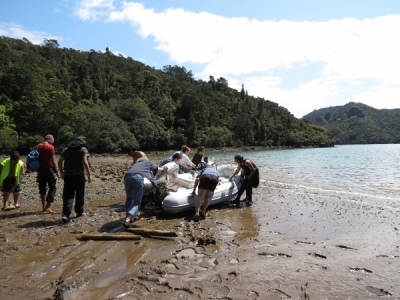 |
10/4/2013: Extra hands
Position: -35°0.72'S, 173°43.88'E
The group from R. Tucker Thompson had no trouble getting our dinghy back afloat.
|
 |
10/5/2013: Whangaroa
Position: -35°2.97'S, 173°44.65'E
We anchored off Whangaroa townhsip and ran the dinghy into the marina there for a walk around.
|
 |
10/5/2013: Custom cars
Position: -35°2.97'S, 173°44.65'E
The Far North Rod and Custom Club was meeting at the local pub. The club members brought a variety of cars, including two vintage Thunderbirds and this custom Chevy.
|
 |
10/5/2013: Marlin hotel pub
Position: -35°2.97'S, 173°44.65'E
We arrived just before the car club did and were lucky to get a seat. We had a great time sitting outside with a view to their cars.
|
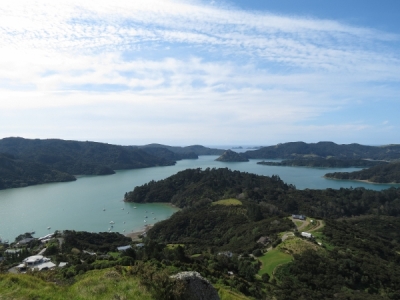 |
10/5/2013: St. Paul's Rock
Position: -35°3.04'S, 173°44.96'E
After lunch, we climbed nearby St. Paul's Rock. The view from the 600-foot summit was spectacular.
|
 |
10/5/2013: Anchorage view
Position: -35°3.04'S, 173°44.96'E
View to the anchorage from St. Paul's Rock. Dirona is the farthes boat out, right of center. The anchorage was peaceful and we enjoyed the township lights after dark.
|
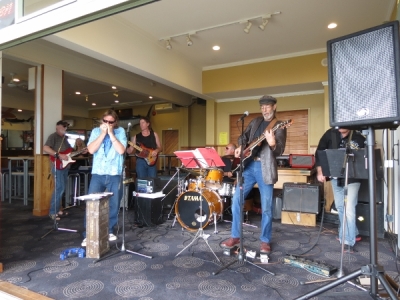 |
10/6/2013: Rockin' the Blues
Position: -35°2.97'S, 173°44.65'E
Rock/blues jam session, billed as "Rockin' the Blues", at the Marlin Hotel pub. We could hear their music playing from the boat, so came in to check them out.
|
 |
10/6/2013: Curbside seating
Position: -35°2.97'S, 173°44.65'E
Patrons had moved tables from the sidewalk alongside the hotel to the other side of the road to watch the band. So we did as well. Here's a video of the scene.
|
 |
10/6/2013: Batter your own
Position: -35°2.97'S, 173°44.65'E
You can bring your own fish to the local cafe, and they will batter and cook it for you for $2.
|
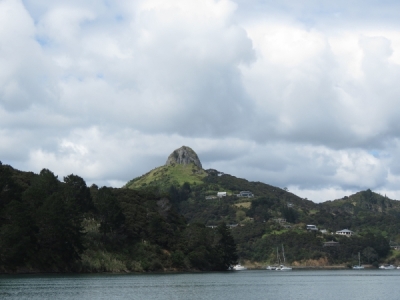 |
10/7/2013: St. Paul's Rock
Position: -35°2.42'S, 173°44.58'E
A last view to St. Paul's Rock, where we'd climbed the day before, as we leave the anchorage.
|
 |
10/7/2013: Sunset
Position: -35°1.17'S, 173°46.31'E
Beautiful sunset in Pararako Bay. The anchorage was calm and private, with great scenery all around.
|
 |
10/8/2013: Water buoy
Position: -35°2.97'S, 173°44.65'E
Coast guard freshwater buoy near the anchorage. We watched a boat pull up, tie off, and take on some freshwater there.
|
 |
10/8/2013: Rough seas
Position: -35°8.70'S, 174°8.40'E
We were thinking of anchoring for the night at Mahinepua Bay, about five miles east of Whangaroa Harbour. But the seas were rough outside the harbour and winds were predicted to be in the steady 30s with 60 knots at some point in the evening. So we opted for more shelter and continued back to the Bay of Islands area to anchor in Kerikeri Inlet.
|
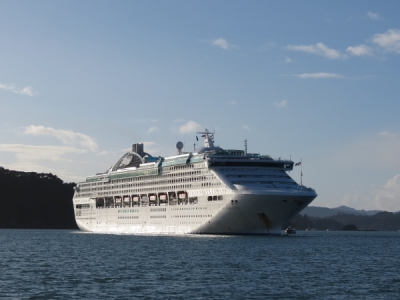 |
10/10/2013: Sea Princess
Position: -35°14.79'S, 174°6.21'E
The cruise ship Sea Princess anchored off Russell.
|
 |
10/10/2013: R. Tucker Thompson
Position: -35°18.66'S, 174°7.19'E
The R. Tucker Thompson, whose crew had helped us launch our stranded dingy, at its home berth in Opua.
|
 |
10/10/2013: Breakfast
Position: -35°18.76'S, 174°7.64'E
Breakfast stop at Opua with the package we'd just picked up from the marina office. It contained the modem from KVH that hopefully will get our V7 main satellite data system up and running again.
|
 |
10/10/2013: Online
Position: -35°18.76'S, 174°7.64'E
After a frustrating time investement and many thousands of dollars, we think we're happy that the V7 is again running.
|
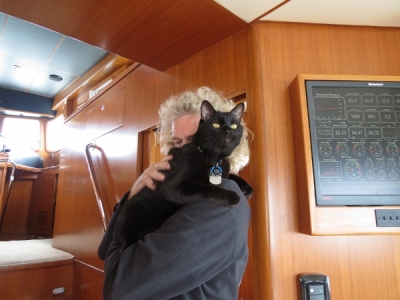 |
10/10/2013: Back from "the resort"
Position: -35°18.76'S, 174°7.64'E
Spitfire is badk from the government-imposed quarantine at "the resort". It's actually a pretty nice place, but he's happy to be home and we're super-happy to have him back.
|
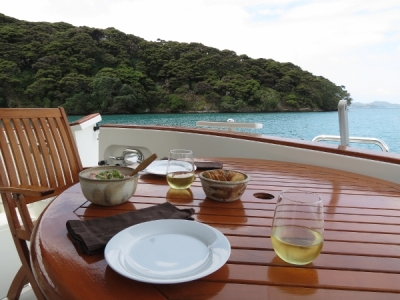 |
10/11/2013: Awaawaroa Bay
Position: -35°13.60'S, 174°11.99'E
Smoked salmond dip for lunch on the back deck in Awaawaroa Bay. The anchorage was sunny, calm and sheltered--and we needed that with 50-knot winds predicted overnight.
|
 |
10/11/2013: Birdwatching
Position: -35°13.60'S, 174°11.99'E
Spitfire and a local mallard. The duck showed little fear--we had to chase it off the swimstep several times--and didn't seem particulary concerned about Spitfire either.
|
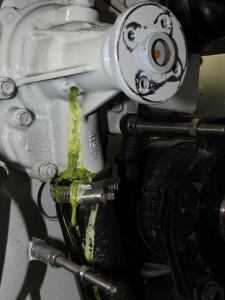 |
10/11/2013: Generator coolant pump
Position: -35°13.60'S, 174°11.99'E
The generator coolant circulation pump seal started to leak--perhaps a little early for this fault at 2,643 hours. We replaced it with the spare and will get a new backup.
|
 |
10/12/2013: Tracks
Position: -35°13.31'S, 174°14.43'E
Urupukapuka Island, as with many of the places we've visited so far in New Zealand, has excellent tracks (local name for trails). We're just loving the tracks--the scenery and views they provide access to are amazing.
|
 |
10/12/2013: Sheep
Position: -35°13.31'S, 174°14.43'E
In addition to tracks, the island also is full of sheep.
|
 |
10/12/2013: Urupukapuka Bay
Position: -35°13.31'S, 174°14.43'E
Looking east across the anchorage.
|
 |
10/12/2013: Big winds
Position: -35°13.31'S, 174°14.43'E
Several storm systems are passing through the area over the the past and next few days. The winds have been blowing in the steady 20s most of the time we've been at the anchorage, but really picked up while we were ashore. Jennifer's hair was a real tangle when we got back to the boat.
|
 |
10/12/2013: Squall
Position: -35°13.31'S, 174°14.43'E
Waiting out a squall under a big tree ashore. At anchor with Dirona is the Ipipriri, a local tour boat that cruises the Bay of Islands taking passengers on shore excursions.
|
 |
10/12/2013: Squall passed
Position: -35°13.31'S, 174°14.43'E
The squall soon passed and we were back to reasonably sunny skies again. During the couple of hours we were ashore, the weather changed from sunny to squalls to sunny to raining and back to sunny again, all mixed with gusty winds and ocasionally calm conditions as well.
|
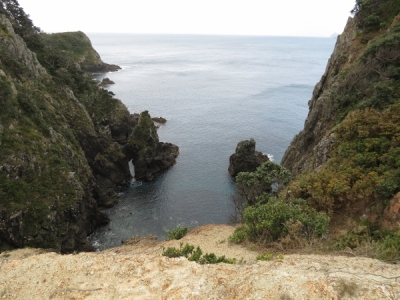 |
10/12/2013: Rugged shoreline
Position: -35°13.31'S, 174°14.43'E
Urupukapuka Island's eastern coast is rugged, complex, and steep. From just beside the track, the shore dropped several hundred feet straight down into the water. Beautiful, but a bit unnerving with these big winds coming from behind.
|
 |
10/13/2013: From the other side
Position: -35°12.79'S, 174°14.63'E
A view from the water to those cliffs we were above yesterday as we make a slow pass around Urupukapuka Island's eastern shore.
|
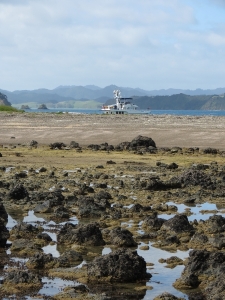 |
10/13/2013: Roberton Island Lagoon
Position: -35°13.89'S, 174°10.13'E
Looking south across the Roberton Island lagoon to our anchorage beyond the beach. We'd not seen some good tide pools since leaving US west coast.
|
 |
10/13/2013: Surge
Position: -35°13.89'S, 174°10.09'E
Surge channel on Roberton Island's north shore with the tidal lagoon from the previous photo in the background. On the rising tide, the surge coming in from these various channels was slowly filling the lagoon. With the open ocean surge and the steep rocky shores, we felt like we were in a cross between the Oregon coast and the Marquesas Islands. Fabulous.
|
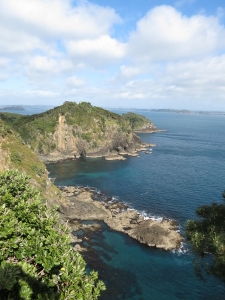 |
10/13/2013: Lookout
Position: -35°13.86'S, 174°9.95'E
Another awesome New Zealand lookout at the top of Roberton Island. This is the view facing northwest.
|
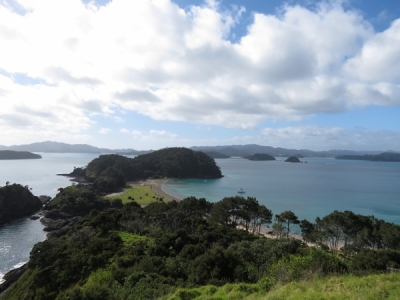 |
10/13/2013: Anchorage view
Position: -35°13.86'S, 174°9.95'E
The view east from the Roberton Island lookout. Dirona is visible anchored right of the isthmus. The scenery here continues to astonish us.
|
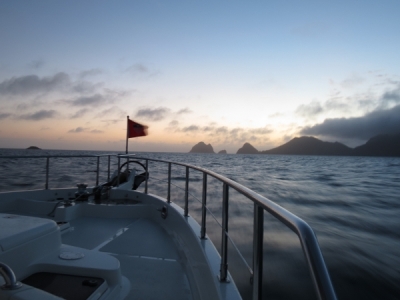 |
10/14/2013: Approaching Cape Brett
Position: -35°10.39'S, 174°17.20'E
We set off before light this morning to make the nine-hour run to Whangarei before predicted gale force northerly winds hit later in the day. This is the view at dawn as we approach Cape Brett.
|
 |
10/14/2013: Cape Brett
Position: -35°10.16'S, 174°19.15'E
About to round Cape Brett at sunrise. Conditions are very calm--a wonderful time of day to be out.
|
 |
10/14/2013: Hole in the rock
Position: -35°10.05'S, 174°19.84'E
The famous "Hole in the Rock" that tour boats run through is on adjacent Motukokako/Piercy Island. But this one on Tiheru Island looks pretty wild.
|
 |
10/14/2013: Tutukaka Coast
Position: -35°24.94'S, 174°28.13'E
Rugged shorline along the Tutukaka Coast. The winds are picking up, but from behind us, so we're making excellent speed.
|
 |
10/14/2013: Bream Head
Position: -35°49.15'S, 174°36.27'E
Bream Head at the entrance to Whangarei Harbour. Apparently you can climb up to the top for sweeping views. The winds are blowing into the twenties now and the waves are starting to pick up a bit. They're still from behind, but we'll be turning more into them soon and the ride likely will get wetter. So far we've not had a drop of spray the entire run.
|
 |
10/14/2013: Turmoil
Position: -35°50.34'S, 174°30.73'E
The tanker Turmoil at Whangarei Refinery.
|
 |
10/14/2013: Into the wind
Position: -35°47.96'S, 174°25.20'E
The gale has arrived and we're now working into steady 25-knot winds with fairly tight waves on the bow. Not a big deal, but definately a wet ride.
|
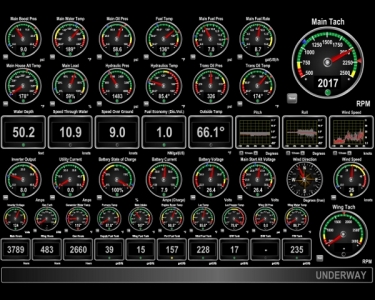 |
10/14/2013: Current
Position: -35°46.74'S, 174°23.38'E
We're doing 9 knots (3rd row, third from left) at 2017 RPM (top right) into a 26-knot wind (fourth row, rightmost). You can click on the picture for a larger view. On flat water at 2,000 RPM we'd be doing about 8.5 knots, so the upstream current must be pretty strong to carry us at 9 knots into a 26-knot wind and tight chop. And wind against current likely is what is standing up the waves so much.
|
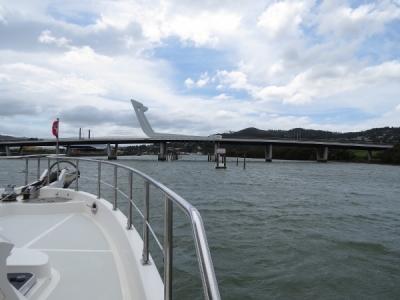 |
10/14/2013: New bridge
Position: -35°44.24'S, 174°20.14'E
We rounded the bend and came across this unexpected bridge. It wasn't on our (very new) chart or in the aerial photos we had of the area. The bridge had a 7.5m clearance--too low for our roughly 30.5ft air draft. With 6 feet of tide, the channel depth was around 9 feet--not much more than our 6'7" draft. So we were a little concerned that we might be delayed here and the tide could fall. Fortunately the operator opened for us immediately when we radioed for a lift.
|
 |
10/14/2013: Reva's
Position: -35°43.47'S, 174°19.60'E
Lunch on the deck at Reva's, overlooking our moorage at the Whangarei Town Basin marina.
|
 |
10/14/2013: Dockland 5
Position: -35°44.39'S, 174°20.30'E
Sailboat on the 70-tonne TravelLift at the Dockland 5 yard. We were checking out the local yards to get the boat lifted for bottom paint, zincs and other minor work done.
|
 |
10/14/2013: Norsand
Position: -35°44.36'S, 174°20.78'E
Commercial fishboat on the 100-tonne rail-trailer system at Norsand.
|
 |
10/14/2013: Kilkenny
Position: -35°43.54'S, 174°19.17'E
Enjoying one of our favourite beers at McMorrissey's Irish Pub in central Whangarei. Kilkenny is suprisingly common in British Columbia where we've spent a lot of our cruising time, but harder to find in the US.
|
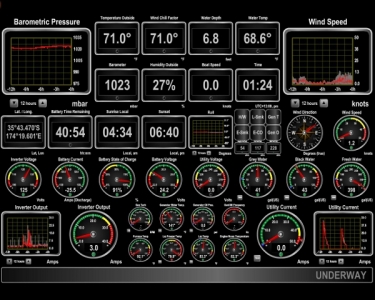 |
10/15/2013: Low tide
Position: -35°43.47'S, 174°19.60'E
We draw 6' 7" and currently are sitting in 6.8 feet of water (top row, center)--just barely above the bottom. We can't enter or leave here except on a mid-tide or higher.
|
 |
10/17/2013: Dawn
Position: -35°43.47'S, 174°19.60'E
Dawn looking south across the marina. The big winds are over and conditions have mostly been sunny, warm and calm since yesterday.
|
 |
10/17/2013: Mmmm ... produce
Position: -35°43.82'S, 174°19.64'E
Part of the produce section at the local Countdown grocery store. We haven't seen a produce section that large since Papeete six months ago. We loved the trip through the South Pacific, but it sure is nice being back where there's such excellent supplies.
|
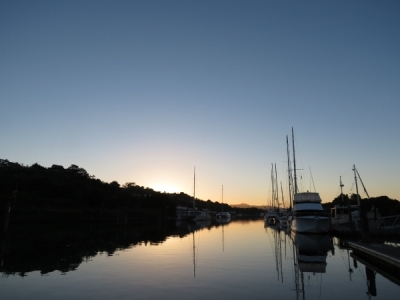 |
10/18/2013: Sunrise
Position: -35°43.47'S, 174°19.60'E
Another beautiful and calm morning at Whangarei Town Basin.
|
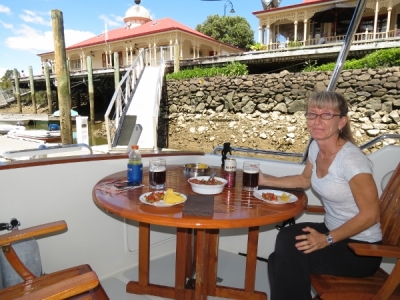 |
10/18/2013: Lunch
Position: -35°43.47'S, 174°19.60'E
Lunch on deck with pints of Kilkenny. How can you not love a country where Kilkenny is sold in the grocery store?
|
 |
10/18/2013: Palmer Canvas
Position: -35°43.47'S, 174°19.60'E
Whangarei-based Palmer Canvas did some excellent work for us, including making this cover for our folding cart that we stow on the flybridge.
|
 |
10/18/2013: Seahawks
Position: -35°43.47'S, 174°19.60'E
Watching the Seahawks beat the Cardinals--the first time we've had the television on since leaving Hawaii. NFL Game Pass is free in New Zealand--we can watch all the NFL games, live or recorded, for free over the internet. Well--not quite free: we did chew through nearly 6GB of data at a cost of around $40USD.
|
 |
10/19/2013: Dinghy label
Position: -35°43.47'S, 174°19.60'E
We replaced the Washington State dinghy registration numbers with a simple "Tender To" label made for us by a local Whangarie shop. Whangarei has excellent marine support--we're knocking lots of items off our to-do list.
|
 |
10/19/2013: All Blacks
Position: -35°43.55'S, 174°19.26'E
Watching the New Zealand All Blacks rugby team play the Australia Wallabies at Dickens Inn. This was the first rugby match we'd watched--the game was fast-paced and quite entertaining.
|
 |
10/20/2013: Northland Vintage Car Club
Position: -35°43.47'S, 174°19.60'E
The Northland Vintage Car Club was meeting at the waterfront this morning. Besides this Ford Model A, the roughly twenty cars also included a Ford Model F and a vintage Rolls Royce. All were in pristine condition.
|
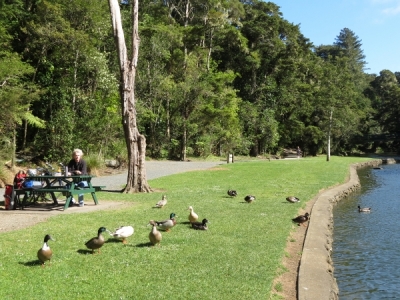 |
10/20/2013: Mair Park
Position: -35°42.74'S, 174°19.81'E
Breakfast with friendly ducks at Mair Park en route to Whangarei Falls, about 3 miles from downtown. Earlier that morning we'd tried to take the dinghy up, but even on a high tide couldn't get much farther than here. So we returned to Dirona and went by bike instead. We were planning to take the track from Mair Park, but bicycles aren't allowed, so we mostly went by road instead.
|
 |
10/20/2013: Whangarei Falls
Position: -35°41.08'S, 174°20.16'E
Beautiful 26m Whangarei Falls were well worth the ride to visit.
|
 |
10/20/2013: At the base
Position: -35°41.08'S, 174°20.16'E
We locked the bikes at the top of the falls and walked an easy trail down to the base.
|
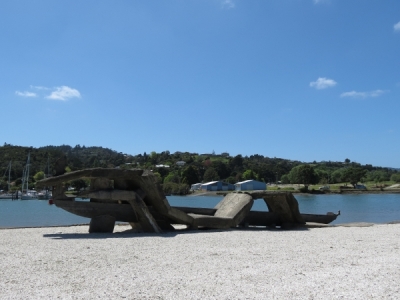 |
10/20/2013: Waka and Wave
Position: -35°43.77'S, 174°19.99'E
From the falls, we returned back to Whangarei and biked along the river walkway. Near the southern end is this stone sculpture of a Maori waka breaking through a massive wave.
|
 |
10/20/2013: Frings
Position: -35°43.57'S, 174°19.61'E
Taking a break at Frings Brewery. The patio is shaped in the form of a boat bow--that really is an anchor on the floor behind James.
|
 |
10/20/2013: Te Matau a Pohe
Position: -35°44.11'S, 174°20.11'E
The new Hatea River rolling bascule bridge, Te Matau a Pohe (Fishhook of Pohe). This was the one that had surprised us on the way to the Town Basin marina--it was completed only a few months ago.
|
 |
10/20/2013: Low tide
Position: -35°44.11'S, 174°20.11'E
Looking up the Hatea River from the Te Matau a Pohe bridge towards the Town Basin at low tide. There's only a few feet of water now--we can only enter or leave at a mid-tide or higher. The dock there is for boats to tie off to while waiting for the bridge to open.
|
 |
10/20/2013: Aground
Position: -35°44.11'S, 174°20.11'E
All along the river, boats sit on the bottom at low tide, some in trenches so the boat doesn't rest on its running gear.
|
 |
10/20/2013: Mt. Parihaka
Position: -35°42.73'S, 174°20.21'E
We next biked up to the Mt. Parihaka lookout. We were totally pooped by the time we'd reached the 241-meter summit, but were glad we'd come, especially on such a clear day. The view was incredible. (Click the picture for a full-screen view of this panorama.)
|
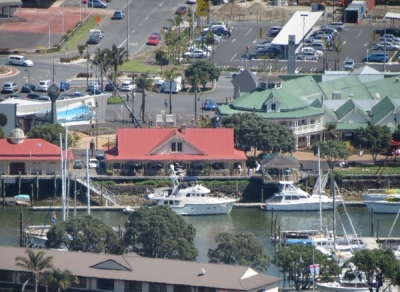 |
10/20/2013: Town Basin
Position: -35°42.73'S, 174°20.21'E
View to our moorage at the Town Basin marina from the Mt. Parihaka lookout.
|
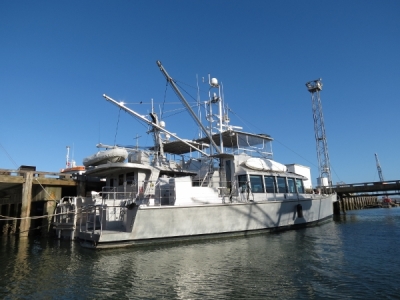 |
10/20/2013: Grey Wolf
Position: -35°44.66'S, 174°20.88'E
After returning back to Dirona from the lookout, we still had a little time left in the day, so set off down river in a dinghy tour. We figured this would be the one day we'd have time to tour around, so wanted to take full advantage of it. Along the way, we saw the FPB Grey Wolf moored at the port. Another brand-new FPB was moored nearby--the FPBs are built locally at Circa Marine.
|
 |
10/20/2013: Limestone Island
Position: -35°47.06'S, 174°21.61'E
Ruins from the old quarry on the south side of Limestone Island.
|
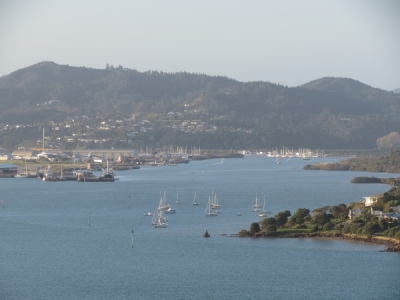 |
10/20/2013: Port Whangarei
Position: -35°47.06'S, 174°21.61'E
Looking north from Limestone Island to Port Whangarei at the mouth of the Hatea River.
|
 |
10/20/2013: Bream Head
Position: -35°47.06'S, 174°21.61'E
View from the summit of Limestone Island southeast across Whangarei Harbour to Bream Head.
|
 |
10/20/2013: Sunset drink
Position: -35°47.06'S, 174°21.61'E
Having a sunset drink at a picnic table on Limestone Island.
|
 |
10/20/2013: A tow
Position: -35°46.71'S, 174°21.55'E
Giving a tow across the waterway to a family whose boat wouldn't start.
|
 |
10/21/2013: Sleeping cats
Position: -35°43.47'S, 174°19.60'E
Two wild cats sleeping in the sun outside Reva's, adjacent to our moorage. A couple of nights back we woke up in the middle of the night with Spitfire nose-to-nose through the glass and howling at the brownish one. It had come on board and had been sleeping on the boat deck under the ladder to the fly bridge.
|
 |
10/21/2013: Warrant of Electrical Fitness
Position: -35°43.47'S, 174°19.60'E
Any boat that plugs into the New Zealand power grid must be inspected in-country and issued a Warrant of Electrical Fitness, along with any cables that will plug into shore. Shown are the cables Erik Hoenderdos at Omori Tech Ltd certified for us, with their certification tags. We also received a sticker to display on the boat, and a Warrant of Electrical Fitness paper certificate. The white cable is our main 50-amp power cable that is wired into the boat. To the right of it is a 16-amp pigtail that we built here in Whangarei. And wrapping around from left to right is the 32-amp pigtail that we built in Papeete, were able to use in Fiji, and can also use here. We've actually only used the 16-amp adapter in New Zealand so far though.
|
 |
10/21/2013: Butter Factory
Position: -35°43.42'S, 174°19.22'E
We cracked up at this sign. We'll definately be back to try it.
|
 |
10/22/2013: Road trip
Position: -36°0.88'S, 174°25.09'E
We rented a car for the day to drive to Auckland to get our visa labels replaced. When we were in Hawaii, we'd applied for visas by mail and been issued 6-month, multiple-entry visas. But the label was wrong and indicated only single entry (among other errors). We didn't have time to send our passports back in before we left Hawaii, so we had to wait until we were here to get the labels fixed. Driving on the left was definately a little different, but we'd gotten good practice on our bikes in Fiji and here in Whangarei.
|
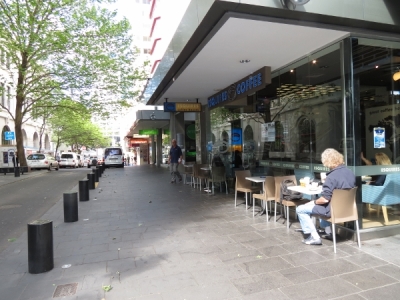 |
10/22/2013: Breakfast
Position: -36°51.07'S, 174°45.82'E
A late breakfast in downtown Auckland after we'd got the visas sorted out. We now have visa labels that allow multiple entries with up to six months on each entry, up to a maximum of 9 months in 18. Our next stop is The Dive Doctor to have the seals replaced in Jennifer's drysuit. At sub-70F, this is drysuit diving territory for us--the locals mostly dive with 7mm wetsuits or drysuits.
|
 |
10/22/2013: Engine oil
Position: -35°43.66'S, 174°19.79'E
We took advantage of the car to pick up a fresh load of engine oil.
|
 |
10/23/2013: On the hard
Position: -35°44.36'S, 174°20.78'E
On the hard at Norsand boatyard for bottom paint, zinc replacement and other minor work. This was the first time we'd been lifted on a rail-trailer, where the boat is pulled ashore while it rests on a track-mounted trailer. All other times we've used a TravelLift, that lifts and carries the boat on straps. We'll post more pictures and a description of the process separately.
|
 |
10/23/2013: Danger pay
Position: -35°43.47'S, 174°19.60'E
We need to install a backing plate for a pad-eye that we'd installed on the Portuguese bridge. Jennifer was the only one that could reach behind to do it, by climbing into the cupboard. She always requests "danger pay" for any job that requires her small size.
|
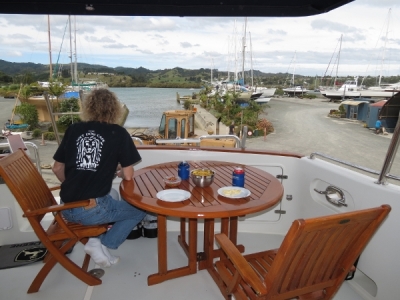 |
10/25/2013: Lunch in the air
Position: -35°44.36'S, 174°20.78'E
Lunch in the sky as a tractor goes by below us.
|
 |
10/26/2013: Battery overheat
Position: -35°44.36'S, 174°20.78'E
Last night was "one of those nights" that sometimes happen on boats. The lazarette smoke/CO alarm went off at 3am. We found a rotten egg smell and a lot of heat in the lazarette, with water dripping from the ceiling. We dug around a bit more and found two batteries at 170F on the outside of the case, and probably well over 300F inside. A normal battery temperature on our boat is around 80F. Two of them were boiling their guts out--one of our eight batteries had gone into thermal runaway and taken its pair with it. We isolated them from the charging system via switch (a nice design on Nordhavn's part), ensured they were cooling, and went back to bed. This morning they were still at 131F (read more).
It looks like we now need eight Lifeline GPL-8DL batteries that list for a booming $8,264. And they are 156 lbs each, which each means we'll be changing a half ton of batteries. Livin' the dream! |
 |
10/26/2013: Cleaning the thrusters
Position: -35°44.36'S, 174°20.78'E
Removing the barnacle and other hard sealife that had built up on the thrusters.
|
 |
10/26/2013: Prop puller
Position: -35°44.36'S, 174°20.78'E
After a bit of cleaning, we soon realized we'd need to remove the bow and stern thruster propellers to properly clean the tubes, gear and propellers. Unfortunately we didn't have a puller, but James made one from a scrap piece of metal.
|
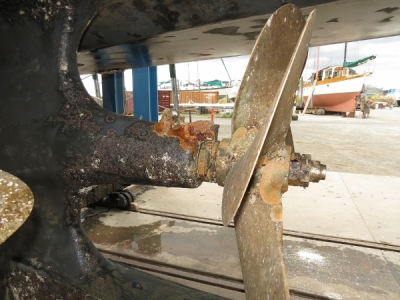 |
10/26/2013: Main prop before
Position: -35°44.36'S, 174°20.78'E
The main propeller just after we'd hauled out. We'd cleaned off the machinery at least once since the last full clean in Hawaii, but the calcerous growth still was pretty bad and difficult to remove.
|
 |
10/26/2013: Main prop after
Position: -35°44.36'S, 174°20.78'E
The main propeller after we cleaned off the growth and polished it.
|
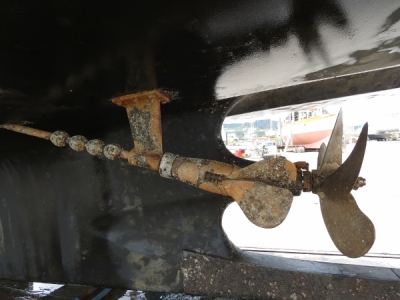 |
10/26/2013: Wing prop before
Position: -35°44.36'S, 174°20.78'E
The auxiliary engine propeller before cleaning. The auxiliary engine, known as a wing engine because it is off to the side, is a backup in case the main engine fails. The wing engine has a completely independent shaft, propeller and fuel system. The propellor itself is a Gori folding propeller, commonly used in sailboats, that folds when not in use to reduce drag.
|
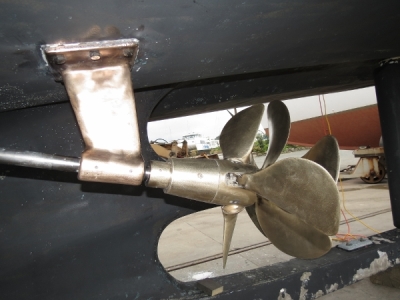 |
10/26/2013: Wing prop after
Position: -35°44.36'S, 174°20.78'E
The wing engine propeller after cleaning and polishing.
|
 |
10/27/2013: Thruster prop
Position: -35°44.36'S, 174°20.78'E
James cleaning the tight spots on a thruster propeller using a wire wheel on a drill. We used a disc grinder with a coarse disc to do most of the polishing.
|
 |
10/27/2013: Zincs
Position: -35°44.36'S, 174°20.78'E
Our zincs were last changed in Hawaii and were in the best shape they'd been in for that period of time. Not being in marinas with the stray current likely contributed to that.
|
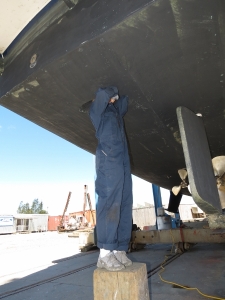 |
10/28/2013: Stern tube
Position: -35°44.36'S, 174°20.78'E
Jennifer cleaning the growth from the stern thruster tube.
|
 |
10/28/2013: Painting the domes
Position: -35°44.36'S, 174°20.78'E
The white dome covers for our satellite dishes are mounted at the top of our stack, adjacent to the dry exhaust, and become soot-covered after long runs in heavy winds. Cleaning up there is difficult, so we're painting them dark grey to make the dirt less obvious.
|
 |
10/29/2013: Grey water discharge
Position: -35°44.36'S, 174°20.78'E
Normally our sink water discharges overboard, but we need to capture it while in the yard. We can direct the discharge to our grey water tanks, but we'd rather not have galley waste water in those tanks if we can avoid it.
|
 |
10/29/2013: Removing the bottom paint
Position: -35°44.36'S, 174°20.78'E
We're putting an epoxy sealant coat over our original gelcoat, so need to first remove the entire anti-fouling paint layer.
|
 |
10/29/2013: Cat launch
Position: -35°44.36'S, 174°20.78'E
Launching a catamaran behind us. Norsand specializes in catamaran haulouts using this custom-built hydraulically-actuated trailer.
|
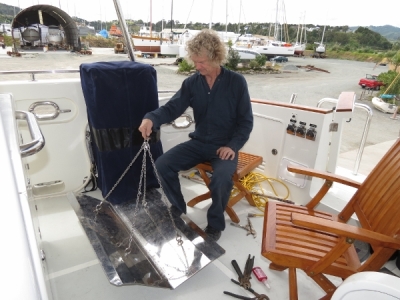 |
10/31/2013: Flopper-stopper repair
Position: -35°44.36'S, 174°20.78'E
Bridon of Whangarei made new flopper-stopper chains for us. We'd temporarily fixed the one chain that had parted at Port Resolution in Vanuatu, and now we replaced them all.
|
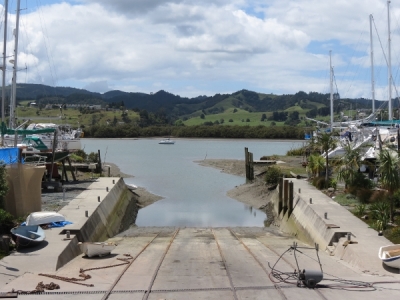 |
11/1/2013: Low tide
Position: -35°44.36'S, 174°20.78'E
Low tide at the Norsand haulout ramp, viewed from our boat in the yard. Definately not the time to be moving boats in and out of the water.
|
 |
11/2/2013: All Blacks
Position: -35°43.54'S, 174°19.17'E
Watching the All Blacks rubgy match against Japan at McMorrissey's Irish Pub. We'd ridden our bikes into town from the yard. New Zealand dominated with a final score of 54 to 6. The All Blacks have an impressive record: they are the current Rugby World Champions, have won over 75% of all their matches, and are leading scorers of all time. They have a winning record against every country they've played and have only lost to seven other countries since their international debut in 1903. We've enjoyed the matches, but the Haka war dance they perform before each one is particularly entertaining, especially with the opposing team trying to look nonchalant about it.
|
 |
11/3/2013: Floodlight supports
Position: -35°44.36'S, 174°20.78'E
Replacing the supports for our stack-mounted floodlights. The original supports were rusting, so we had stainless steel replacements made in Whangarei.
|
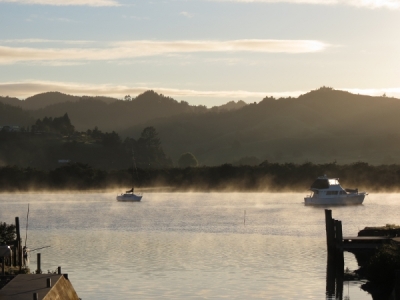 |
11/4/2013: Sea smoke
Position: -35°44.36'S, 174°20.78'E
Sea smoke on the Hatea River viewed from our boat in the yard.
|
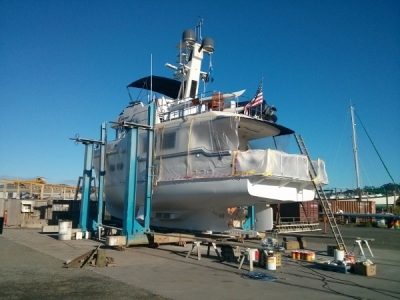 |
11/4/2013: White bottom
Position: -35°44.36'S, 174°20.78'E
Three coats of epoxy sealant are in place, and we're now ready for the anti-fouling bottom paint. The bottom looks a little odd all white--we've not seen it that color since the South Coast Marine yard in Xiamen, China.
|
 |
11/4/2013: Slipway office hours
Position: -35°44.36'S, 174°20.78'E
Haulouts and launches can only be done near high tide. The slipway team ends up working long hours, but has a pretty good sense of humor about it.
|
 |
11/4/2013: PropSpeed
Position: -35°44.36'S, 174°20.78'E
PropSpeed on Dirona's main propeller. PropSpeed is designed to prevent marine growth on mechanincal gear by being slippery, unlike anti-fouling paint that retards marine growth through toxicity. Anti-fouling paint doesn't work well in this application because it almost immediately wears off the propeller. In the past we've gotten away with no coating on the propellers because we normally operated in cold water and used our boats frequently. Even with frequent use, however, water temperatures upwards of 80F in the South Pacific seemed to allow growth in minutes.
|
 |
11/4/2013: Wing engine propellor
Position: -35°44.36'S, 174°20.78'E
PropSpeed on the auxiliary engine propeller.
|
 |
11/4/2013: Thruster propeller
Position: -35°44.36'S, 174°20.78'E
And PropSpeed on the bow thruster propeller.
|
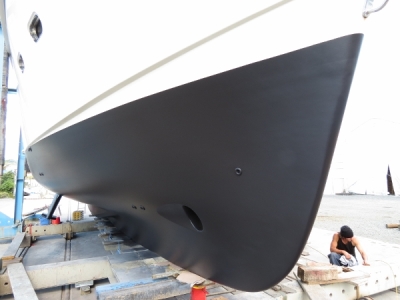 |
11/4/2013: Bottom paint
Position: -35°44.36'S, 174°20.78'E
Our bottom, freshly painted with about 40L of Joton SeaForce 30 in two coats. The paint we normally use, Petit Trinidad SR, isn't available in New Zealand.
|
 |
11/4/2013: Stern thruster
Position: -35°44.36'S, 174°20.78'E
James re-installing the stern thruster propellers. Not an easy job when you can only reach one arm at a time inside and can't look at the same time.
|
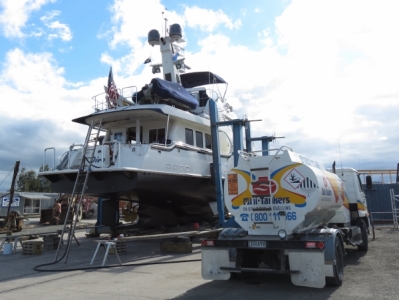 |
11/4/2013: Fueling
Position: -35°44.36'S, 174°20.78'E
We took on 5,200 liters of diesel while at the yard. We've always found it really convenient to buy fuel in bulk from a tanker truck, but you can't beat this for easy.
|
 |
11/5/2013: Launching
Position: -35°44.36'S, 174°20.78'E
The wheel loader pulling the rail-trailer back towards the water.
|
 |
11/5/2013: Swimstep
Position: -35°44.36'S, 174°20.78'E
The swimstep going underwater, with trapped air bubbling out, as we slowly submerge at an angle on the ramp.
|
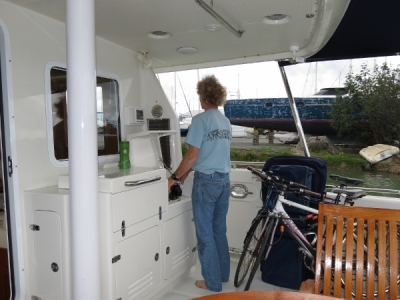 |
11/5/2013: Aft helm
Position: -35°44.36'S, 174°20.78'E
James navigating from the aft helm as we are released from the cradle.
|
 |
11/5/2013: Pressure test
Position: -35°50.25'S, 174°28.02'E
We'd noticed a small leak at the keel cooler hose connections after launching. It appears to have started leaking just before we went into the yard and the change of angle of the boat during launch made it more obvious. We tightened the hose clamps and pressure-tested the system to verify the fix.
|
 |
11/6/2013: Bream Head
Position: -35°50.25'S, 174°28.02'E
View east above the clouds to Bream Head at the entrance to Whangarei Harbour from our new moorage at Marsden Cove Marina. The marina is less than a decade old, well-built and very clean, with good security and an excellent restaurant on-site. The only downside is that Whangarei is about a half-hour's drive away, but cars can be rented here for a flat rate of $40NZ per day, so it works out pretty well.
|
 |
11/6/2013: Lock
Position: -35°50.26'S, 174°27.95'E
A lock near our slip leads into the the Marsden Cove Marine Village canal. The lock is radio-controlled and automatic--the water inside is kept near high tide level.
|
 |
11/7/2013: Circa Marine
Position: -35°44.52'S, 174°20.50'E
Michael Jones introduced us to Bruce Farrand, director of Circa Marine, who invited us for a tour of their facility at the port area in Whangarei where the FPB boats are built. Pictured on the right is the first FPB 97 under construction, with its flybridge on the floor in the foreground. An FPB 64 is in the background on the left, behind an aluminum sailboat. We very much enjoyed the tour, and were quite impressed with the scale of the facility and the workmanship quality on the boats we toured.
|
 |
11/9/2013: Mystic Moon
Position: -35°50.26'S, 174°27.95'E
View to our moorage from the lock. Most New Zealand marinas we've seen have posts between the slip fingers to secure the boat. Next to us is Selene 53 Mystic Moon. We first met owners John and Kathy Youngblood when we presented at the 2005 Selene Rendezvous in Roche Harbor, WA. We last saw Mystic Moon much earlier in the trip at Baie de Taiohae in French Polynesia.
|
 |
11/8/2013: Stains
Position: -35°50.25'S, 174°28.02'E
The Norsand yard is clean, but there's no way to visit a boatyard without some fallout on the boat. Having the entire bottom paint sanded off to apply an epoxy sealant and repainting it invariably ends up with some sanding debris on the boat. The boat was washed at the yard, but we apparently missed the flybridge and eyebrow biminis. Two days of heavy rain washed yard debris down onto the hull, staining it. We've found boat wax is the best way to remove them (we use 3M Cleaner and Wax).
|
 |
11/8/2013: Waxing
Position: -35°50.25'S, 174°28.02'E
Using the dinghy, supported by the crane, as a scaffold to wax away the stains. This was the first time we'd tried using the dinghy this way, and it worked very well, allowing us to reach all of the aft half of the port side. Otherwise, we'd need to turn the boat around to reach the port side from shore--not a big deal, but a slight hassle.
|
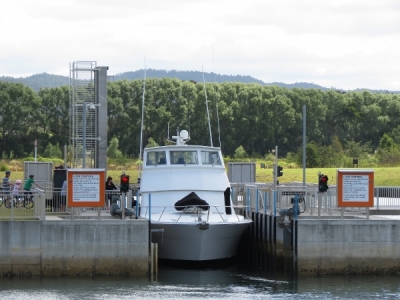 |
11/9/2013: Tight squeeze
Position: -35°50.26'S, 174°27.95'E
Boardroom is about as big a boat as the Marsden Cove lock can handle. The captain did an excellent job of bringing the boat through--he made it look easy.
|
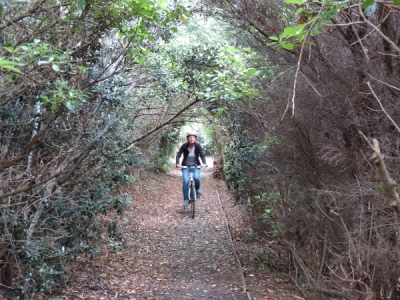 |
11/10/2013: Tree archway
Position: -35°50.20'S, 174°28.90'E
We rode our bikes from Marsden Cove along a well-maintained gravel track to Marsden Point.
|
 |
11/10/2013: Marsden Point
Position: -35°49.93'S, 174°28.97'E
Pedestrain/fishing pier overlooking the bay at Marsden Point.
|
 |
11/10/2013: Refinery Visitors Center
Position: -35°50.44'S, 174°29.23'E
The oil-refinery at Marsden Point has an excellent visitor's center featuring this full-scale model. The model was built as a reference for the construction process and includes every pipe, color-coded by what it carries, and all building. A sound and light show higlights the various components and explains the refining process.
|
 |
11/10/2013: Bream Head
Position: -35°50.21'S, 174°29.47'E
View to Bream Head across a small public access beach at the head of Ralph Trimmer Drive.
|
 |
11/10/2013: Pipes
Position: -35°50.74'S, 174°29.27'E
Looking into the complex run of pipes that make up only a small portion of the refinery.
|
 |
11/10/2013: Bream Bay
Position: -35°51.12'S, 174°29.36'E
This beach at Bream Bay had great ocean views and wonderfully soft sand.
|
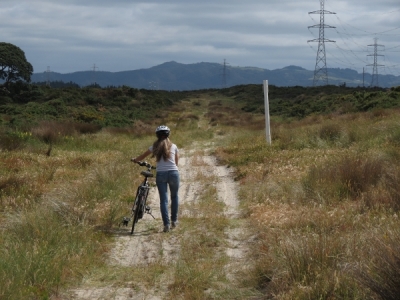 |
11/10/2013: Raukaka Pipeline Track
Position: -35°51.31'S, 174°29.01'E
We took the track from the beach at Bream Bay south to Marsden Village. We enjoyed the track, but the sand was too soft to support the bikes so we walked them part of the way.
|
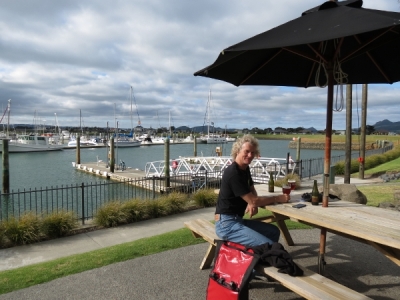 |
11/10/2013: Waterline Cafe
Position: -35°50.33'S, 174°28.15'E
Finishing the day with a beer on the patio at the Waterline Cafe.
|
 |
11/10/2013: Guy Fawkes fireworks
Position: -35°50.25'S, 174°28.02'E
Guy Fawkes celebrations are huge in New Zealand and seem to last at least a week--we've been seeing fireworks nightly for days. The capitol city of Wellington put on an amazing display on Saturday. This photo is was taken from the boat of a nearby school's display.
|
 |
11/20/2013: UPS store
Position: 47°36.23'N, -122°20.12'W
At our UPS mailbox in Seattle, sorting through our packages. We'd returned to the US for a couple of weeks and ordered a load of spares and supplies that either weren't readily available in New Zealand, were more expensive there, or weren't compatible with our on-board power. The purchases included spare coolant pumps for the generator and the hydraulics, tools to adjust the Deere engine valves, a spare charger and DC-DC converter, an inverter, a disc grinder and attachments, a backup drill, a spare anchor swivel and chain grab, a new hairdryer, Tidy Cats Breeze litter pads, and two cameras.
|
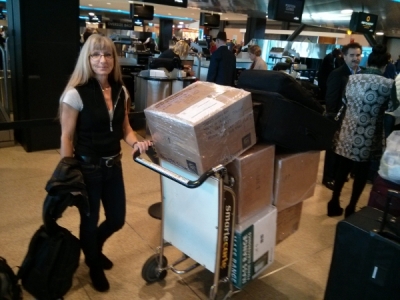 |
11/24/2013: Luggage
Position: 47°26.64'N, -122°18.14'W
At the Seattle airport with our luggage: five boxes and one suitcase. At the UPS store, we'd unpacked everything and repackaged them into airline-friendly units (maximum 50 pounds and 62 linear inches). For a suitcase we just brought one with us: our Stahlsac dive bag. The Stahlsac is soft-sided and easy to manage, yet holds a huge amount and is wheeled for easy transport.
|
 |
11/25/2013: Cockpit tour
Position: -37°0.53'S, 174°46.94'E
After landing, we were invited into the cockpit of the Air New Zealand 747-400 that carried us from San Francisco to Auckland. The 20-year-old plane is near end of life, but was one of the first with glass cockpit instrumentation.
|
 |
11/26/2013: Back at Reva's
Position: -35°43.47'S, 174°19.60'E
Back in front of Reva's at the Town Basin marina in Whangarei. We'll be here for a couple of weeks to get some electrical work done and hopefully get those batteries replaced.
|
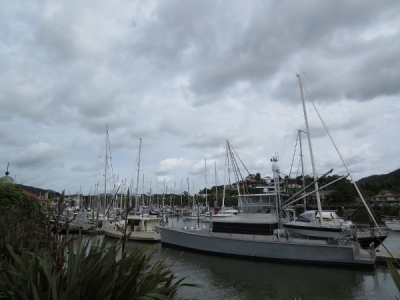 |
11/27/2013: Tiger
Position: -35°43.47'S, 174°19.60'E
FPB Tiger moored just down from us at the Town Basin. We last spoke with her owners, John and Sandy Henrichs, at the Aquarium Cafe in Tonga.
|
 |
12/2/2013: Wire run
Position: -35°43.47'S, 174°19.60'E
James and Ben Haselden of McKay Marine Electrical, an excellent local contracter, looking for a route through the wire run at the bottom of the stateroom stairs. We're installing a 240V inverter and need to run cable from the lazarette DC panel to the pilot house. The wire run is through the engine room, under the MSR berth and up the wall here into the pilot house. Mckay is doing this work for us, and also will be replacing the battery bank. Whangarei has many skilled tradespeople and is an excellent place to get boat work done--it reminds us of Ballard back home in Seattle.
|
 |
12/2/2013: New cable
Position: -35°43.47'S, 174°19.60'E
The new cable coming up into the pilot house.
|
 |
12/2/2013: Storage
Position: -35°43.47'S, 174°19.60'E
As a consequence of unloading the area under the MSR berth, we found a great location to stow our two spare steering rams. One is the used part that we'd replaced in Fiji, the second is a new one that we ordered in Whangarei through All Marine.
|
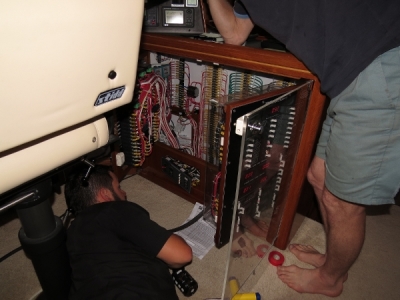 |
12/3/2013: Breaker panel
Position: -35°43.47'S, 174°19.60'E
James and Ben discussing the installation at the pilot house breaker panel.
|
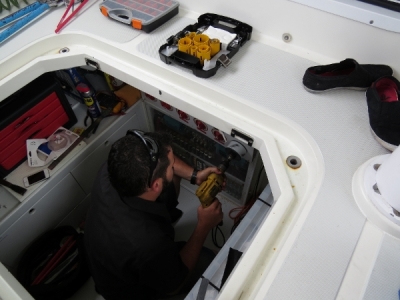 |
12/3/2013: DC panel
Position: -35°43.47'S, 174°19.60'E
Ben using a 92mm hole saw to drill a hole in the lazarette DC panel for a new switch.
|
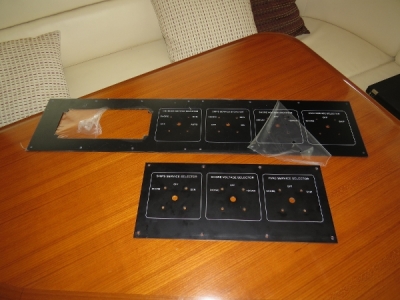 |
12/3/2013: New faceplate
Position: -35°43.47'S, 174°19.60'E
Engraving Systems created a beautiful new faceplate for the pilot house breaker panel to support a fourth switch. The original three-switch faceplate is shown below. The large rectangle in the new faceplate is for an existing extension panel.
|
 |
12/3/2013: Panel relocation
Position: -35°43.47'S, 174°19.60'E
Ben using a Fein saw to cut a new hole in the pilot house breaker panel to relocate the small extension panel near his right hand.
|
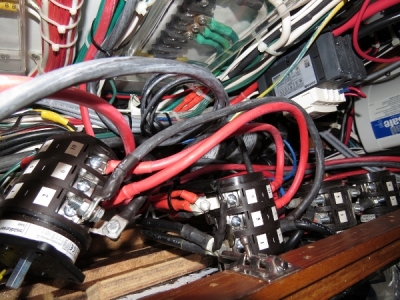 |
12/3/2013: New switches
Position: -35°43.47'S, 174°19.60'E
The new four-way switches partially wired in. One switch has eight wires to it and the other has twelve--a lot of connections.
|
 |
12/4/2013: Backup snubber
Position: -35°43.47'S, 174°19.60'E
We brought a new chain grab back with us from the US, and Norsand braided on 10m of 19mm line. This will be our new spare to replace the one we put into service when our snubber parted in Aneityum, Vanuatu.
|
 |
12/4/2013: Inverter mounting plate
Position: -35°43.47'S, 174°19.60'E
Absolute Stainless built this mounting plate for the new inverter that attaches to a support post in the lazarette. This is looking from port to starboard--the inverter will face aft.
|
 |
12/6/2013: Maori performance
Position: -35°50.32'S, 174°28.04'E
The Whangarei Marine Promotions Group put on a "meet and greet" at Marsden Cove marina for new international arrivals. Buses brought people in from Opua and Whangarei for the event, which started with a Maori (native New Zealander) welcome performed by the local high school troupe. They were quite good, reminding us of the All Blacks Haka war dance. The event was fun--we got a chance to chat with people we'd not seen since Beveridge Reef and Moorea in the Society Islands.
|
 |
12/7/2013: Low tide
Position: -35°43.47'S, 174°19.60'E
We've seen some low tides at the Town Basin, but this is the lowest so far. We draw 6' 7" and have got to be pretty close to touching bottom. But as the depth dropped below seven feet, the sounder stopped reading, so we can't actually tell.
|
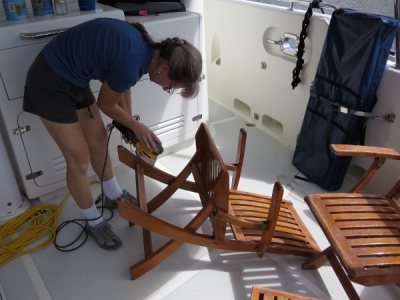 |
12/8/2013: Sanding
Position: -35°43.47'S, 174°19.60'E
Sanding the teak before repainting. We didn't want to maintain wood, so when we ordered the boat we asked Nordhavn to eliminate all exterior teak--the transom caprail was all that remained. And then we bought teak deck furniture. Go figure. But we do like the look though, so don't regret the furniture purchase.
|
 |
12/8/2013: Tight squeeze
Position: -35°43.47'S, 174°19.60'E
Privilege 745 charter boat Cattitude leaving the Town Basin with not much room to spare.
|
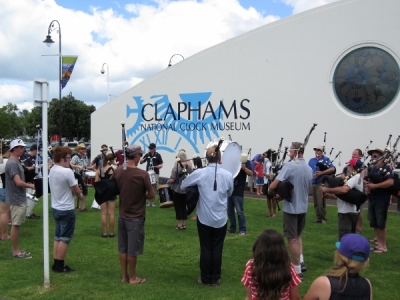 |
12/8/2013: Pipers
Position: -35°43.51'S, 174°19.60'E
At least a dozen pipers, with a drum accompaniment, were playing in the park near our berth. Playing the pipes is difficult--they sounded excellent.
|
 |
12/9/2013: Painting
Position: -35°43.47'S, 174°19.60'E
In May of 2012, we stripped all the teak, sealed it with Mar-X-Ite, then applied Cetol Marine Light and Cetol Marine Gloss. Bill and Kay O'Meara from N62 Anna Mae recommended the procedure and it has worked very well. We'd put extra layers on the caprail and the cockpit table surface and they still looked perfect even after the hot South Pacific sun--they'll just need a maintenance coat or two of Marine Gloss. But we didn't coat the chairs and table legs as well, so they needed a little extra upkeep. Here Jennifer is applying another layer of Marine Light to the table legs.
|
 |
12/11/2013: Ducklings
Position: -35°43.47'S, 174°19.60'E
It's duckling season in Whangarei. A new batch of fluffy ducklings show up seemingly every day. Our cat Spitfire finds them quite interesting, but the mother ducks are pretty fierce so Spit usually watches just out of beak range.
|
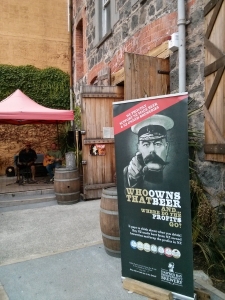 |
12/11/2013: Butter Factory
Position: -35°43.42'S, 174°19.22'E
We loved the Butter Factory's patio closed sign, and returned once their patio was finished. It's since become one of our favourite spots: the owners focus on local products, the more local the better--even their hot sauce is made in Whangarei. The staff are unique and friendly, and they frequently have good live music on the patio, again often from Whangarei or the surrounding area.
|
 |
12/12/2013: Gloss coat
Position: -35°43.47'S, 174°19.60'E
Applying the first of several gloss coats to the boat deck furniture. It will be nice to have this job behind us.
|
 |
12/13/2013: In with the new
Position: -35°43.47'S, 174°19.60'E
Our new batteries arrived today: 1/2 ton of them shipped by boat from DC Battery Specialists in Miami (read more). We ordered new batteries after two had gone into thermal runaway about six weeks ago (read more).
|
 |
12/13/2013: Out with the old
Position: -35°43.47'S, 174°19.60'E
The old batteries ready for disposal. McKay Marine Electrical worked with us on the battery install, and will remove the old ones.
|
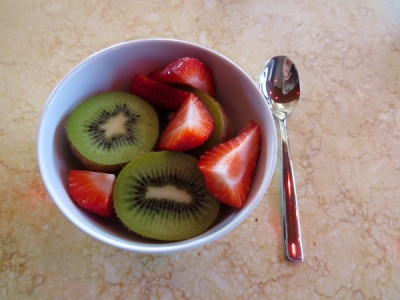 |
12/14/2013: Fresh fruit
Position: -35°43.47'S, 174°19.60'E
We have fresh kiwifruit for breakfast most mornings. Each country we've visited so far has had some kind of local fruit that we just love, from pamplemouse in French Polynesia to lemons/limes in Vanuatu.
|
 |
12/14/2013: A good deed
Position: -35°43.49'S, 174°19.61'E
This parent and two kids bailed out someone's dinghy that had sunk at the dock due to heavy rain some days earlier.
|
 |
12/15/2013: Laundry
Position: -35°43.49'S, 174°19.61'E
We normally do laundry on board. But with the three commercial-sized machines here, we can do larger loads and in parallel, so the whole job goes much faster. And the laundry room is only steps away from Dirona--so it's only slightly more hassle than doing the laundry on board.
|
 |
12/15/2013: Changing UPS battery
Position: -35°43.47'S, 174°19.60'E
It appears that Dirona has gotten to that age where all the battery systems are needing to be replaced. The UPS low-battery replacement alarm has been going off periodically for the last couple of weeks. Fortunately, the battery is commonly-used in emergency lighting systems and easy to obtain locally.
|
 |
12/15/2013: Juice on the Loose
Position: -35°43.45'S, 174°19.54'E
Juice on the Loose playing in the free blues show at the Town Basin today. They sounded great.
|
 |
12/16/2013: Wing engine valve adjustment
Position: -35°43.47'S, 174°19.60'E
The wing engine rocker arm cover off in preparation for adjusting the valves. The next valve adjustment will be due after another 600 hours of operation.
|
 |
12/16/2013: Main engine valve adjustment
Position: -35°43.47'S, 174°19.60'E
Using a feeler gauge to adjust the main engine valves--James adjusted the generator valves as well. The Deere will be due again in 2,000 hours, and the generator in 1,000 hours.
|
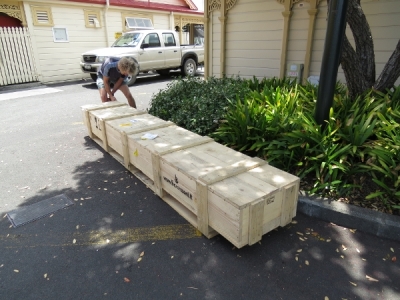 |
12/16/2013: New pasarelle
Position: -35°43.47'S, 174°19.60'E
When we ordered the boat, we specified a Besenzoni passerelle (gangway) with a socket in the swimstep and in the gunnel. One end of the passerelle fits in the socket and the other rests ashore on wheels. The design is that we'd use the gunnel socket for high docks and the swimstep for lower docks. But when we extended the swimstep two feet, the passerelle could no longer reach shore from the gunnel socket unless the boat is perilously close. In Papeete, we'd designed a good system using our stepladder and the crane, but we still wanted a longer passerelle. Several months back, we'd ordered a meter-longer model from a New Zealand distributor. It finally arrived today, direct from Besenzoni in Italy, in a coffin-sized box fit for a basketball player. Fortunately the passerelle itself was much smaller and easier to manage than the box.
|
 |
12/17/2013: A better view
Position: -35°43.47'S, 174°19.60'E
In the space forward of the engine room steps is a major hose run and the aft keel-cooler connections. The only way to see in is through a floor hatch in the master stateroom. But this is a slight hassle to access, and gives very poor visibility to much of the gear in that area, and the keel cooler connections in particular. So we added an inspection hole in the steps. The bulkhead behind is 1.5" thick and was difficult to cut through--we sacrificed one jigsaw blade in the process.
|
 |
12/17/2013: New pie-eye
Position: -35°43.47'S, 174°19.60'E
The completed job with the new pie-eye in place. Now we can easily inspect the entire area.
|
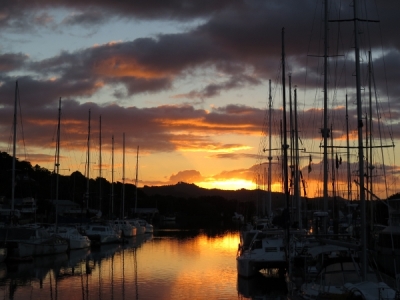 |
12/18/2013: Sunrise
Position: -35°43.47'S, 174°19.60'E
Sunrise looking down the Hatea River from our moorage at the Whangarei Town basin.
|
 |
12/19/2013: New inverters
Position: -35°43.47'S, 174°19.60'E
The new Victron 3,000-watt 120-volt inverters arrived this morning. The two inverters are combined to provide a split-phase 240-volt service of 6,000 watts.
|
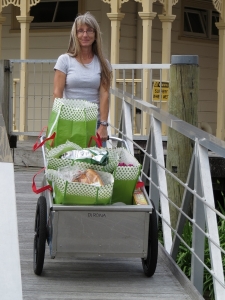 |
12/19/2013: Provisioning
Position: -35°43.47'S, 174°19.60'E
Jennifer returning from a provisioning trip. A large grocery store is just across the road from the marina. The foldable cart we got back in California has been used heavily throughout this trip.
|
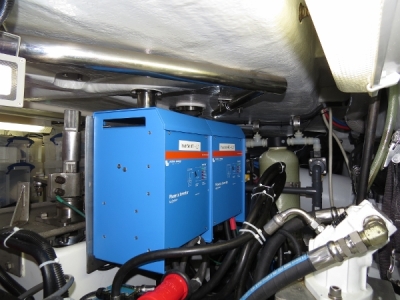 |
12/19/2013: Inverters installed
Position: -35°43.47'S, 174°19.60'E
Our two new Victron inverters mounted on a plate attached to a post in the lazarette.
|
 |
12/20/2013: Look Ma, no generator!
Position: -35°43.47'S, 174°19.60'E
Heating croissants in the oven using inverter-supplied 240 volts. On 50-cycle shore power, we could previously power the oven only by running the generator.
|
 |
12/21/2013: Alucia
Position: -35°44.76'S, 174°20.87'E
While out in the dinhgy, we passed the 183' expedition vessel Alucia on the hard at the Ship Repair NZ yard. That's a lot of boat.
|
 |
12/21/2013: Loading nets
Position: -35°45.44'S, 174°21.01'E
Loading nets onto the fishing vessel San Nanumea. They still were working on it when we returned back upriver a couple of hours later.
|
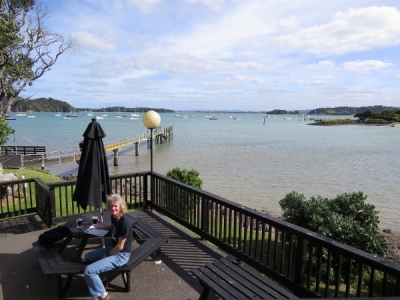 |
12/21/2013: Parua Bay Tavern
Position: -35°46.38'S, 174°27.11'E
Drinks on the deck at the Parua Bay Tavern. Our dinghy is just visible tied off to the left end of the jetty.
|
 |
12/23/2013: Final provisioning
Position: -35°43.47'S, 174°19.60'E
The last load of groceries, this one from a store a little beyond walking distance, before we leave Whangarei.
|
 |
12/23/2013: Leaving Town Basin
Position: -35°43.47'S, 174°19.60'E
A wave goodbye from marina manager Brian Caulton as we depart our slip at Town Basin. We had an excellent stay in Whangarei and the Town Basin was one of the best marinas of the trip.
|
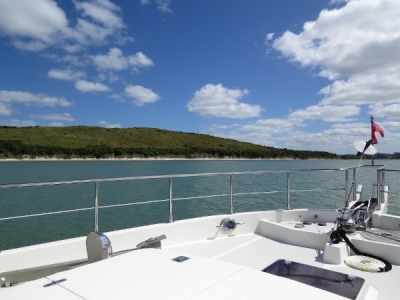 |
12/23/2013: Limestone Island
Position: -35°46.80'S, 174°21.51'E
Anchored off Limestone Island. It's great to be back in the wilds once again.
|